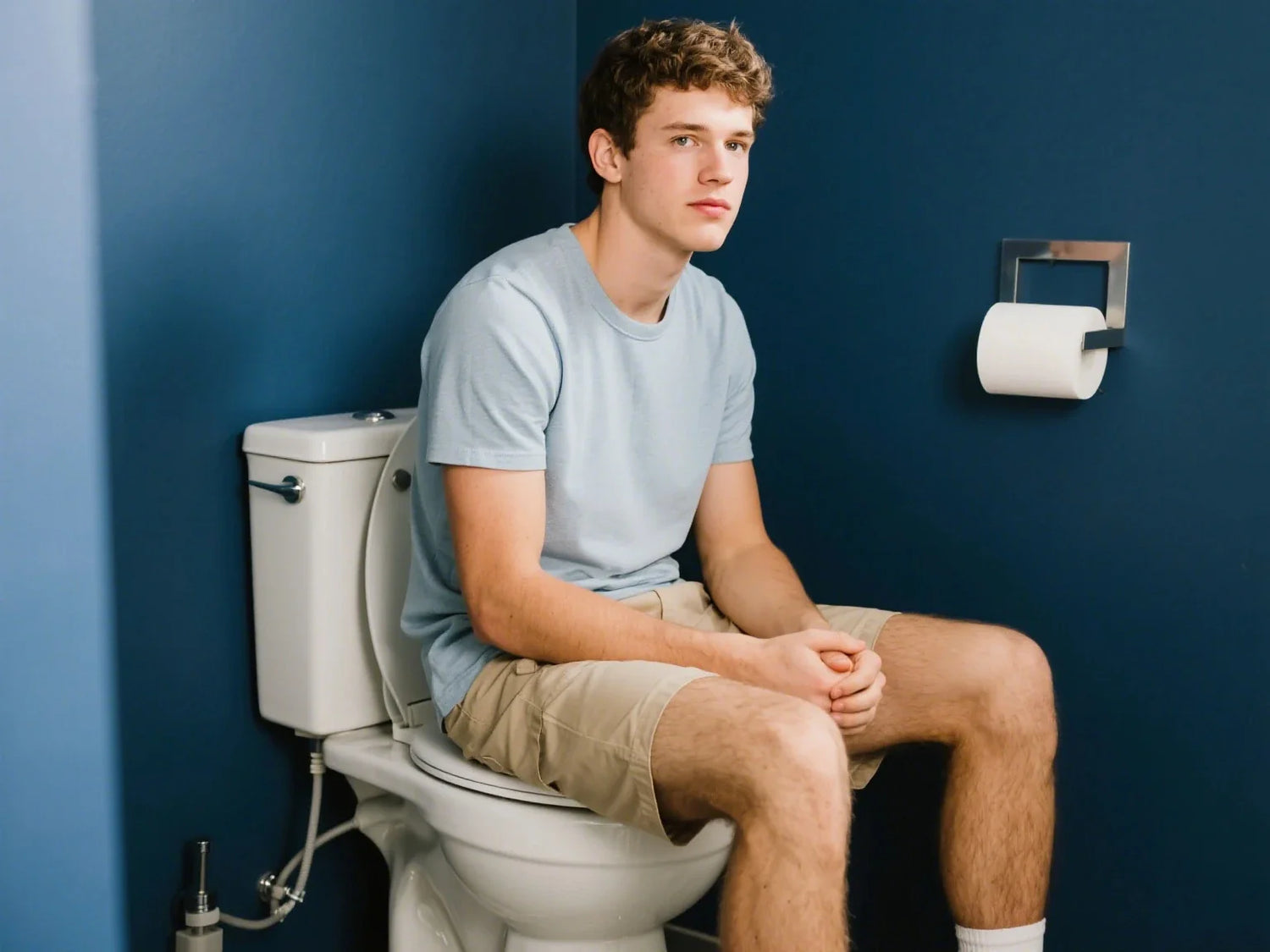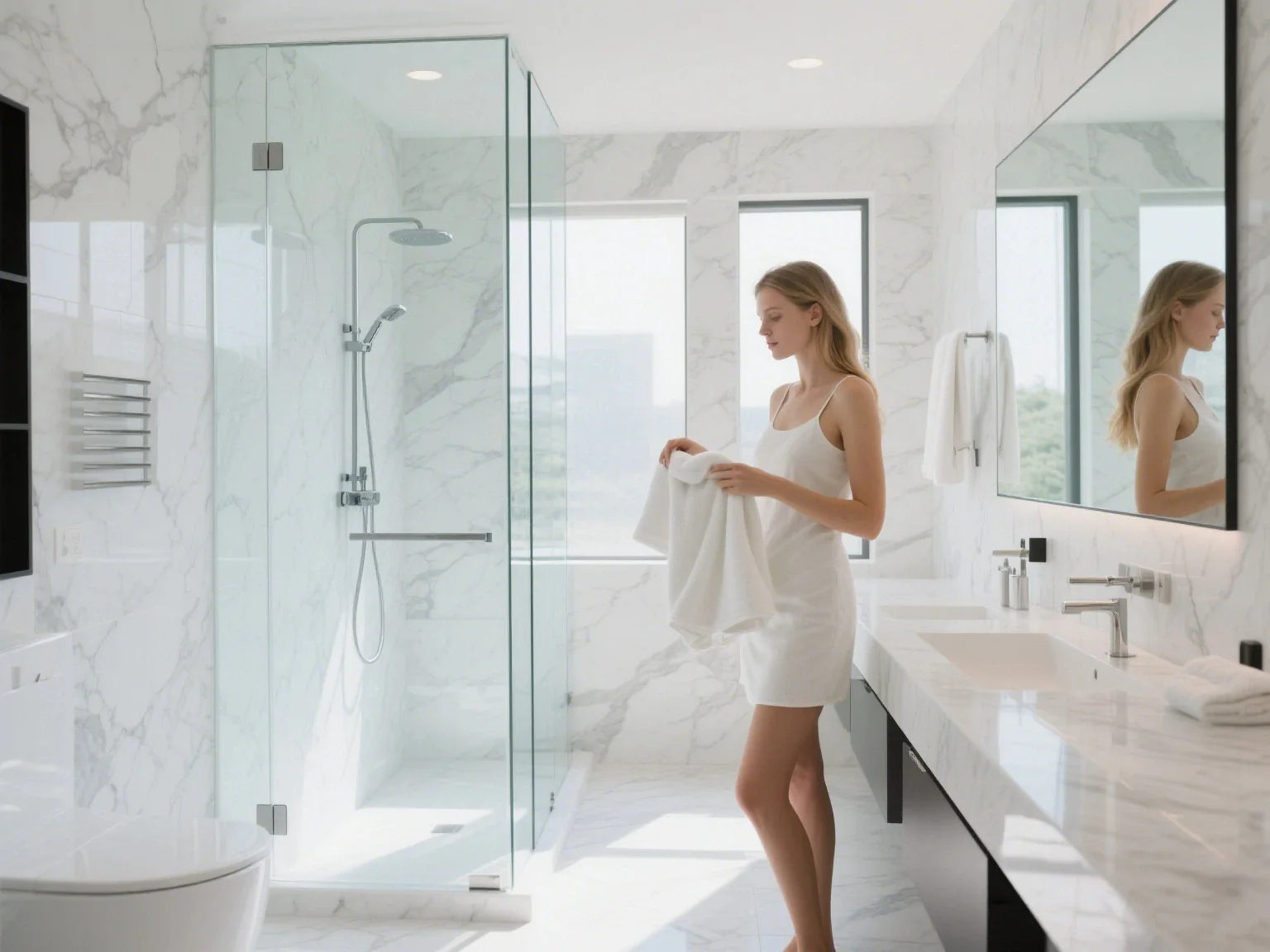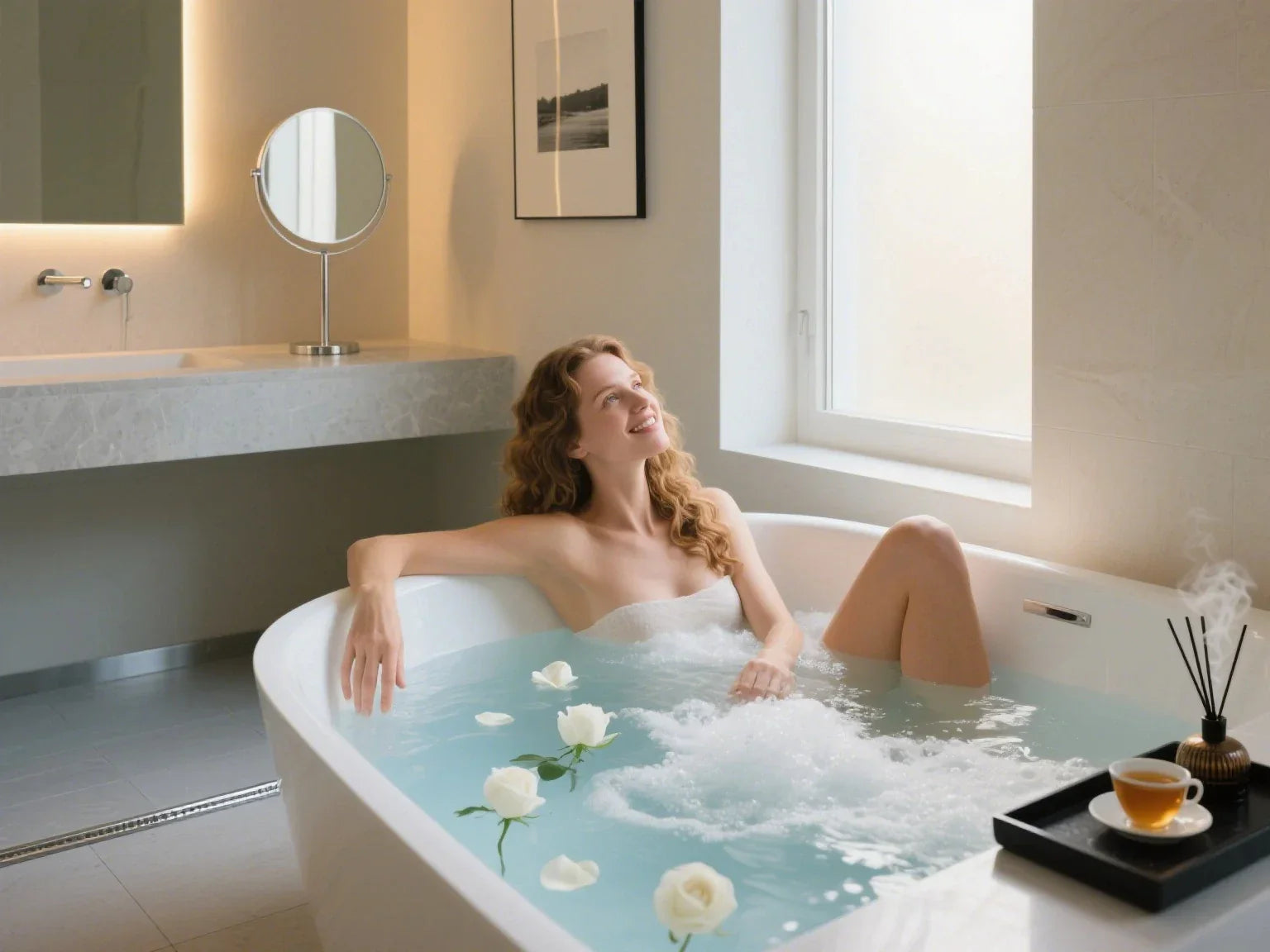How to Choose a Toilet: Quick Answers (Start Here)
The 6 Decisions You Must Nail (60-Second Overview)
Space and Measurements
Toilet Types
- One-piece toilet: Sleek design with no gap between the tank and bowl, making cleaning easier. They cost more but look modern and are less prone to leaks.
- Two-piece toilet: A classic choice, easier to transport and often more affordable, with plenty of size options.
- Wall-mounted toilet: Ideal for tight spaces and easy floor cleaning. Requires an in-wall tank system and professional installation.
Bowl Shape
- Elongated toilet bowl: About two inches longer than round bowls, providing added comfort for adults.
- Round toilet bowl: Saves space and is better for compact bathrooms or powder rooms. Be careful—elongated bowls in small spaces can feel cramped.
Height
- Standard height toilets: About 14–15 inches from floor to seat, suitable for kids and shorter adults.
- Chair/comfort height toilets: 17–19 inches high, making it easier for tall users, seniors, or anyone with mobility challenges. Comfort-height toilets now account for around 60% of U.S. toilet sales, reflecting growing demand for ergonomic bathroom fixtures.
Flush Performance and Water Use
Easy-Clean Designs and Features

Fast Picks by Household Type (who you are → what to buy)
- Small Bathrooms or Powder Rooms: Choose a round-bowl two-piece toilet with a 10- or 12-inch rough-in. If you’re renovating and can add wall support, consider a wall-mounted toilet to create an open, modern look.
- Families with Children: Go for a durable elongated bowl with a high-performing gravity or pressure-assist system. A side lever and soft-close seat will be easier for kids to use.
- Seniors or Users with Mobility Issues: Select a chair-height toilet (17–19 inches) with an elongated bowl and clear floor space that aligns with ADA guidelines. A heated or bidet seat adds extra comfort.
- Eco-Focused or Water-Conscious Homes: Stick to WaterSense-certified models at 1.28 GPF or less. Consider dual-flush toilets but make sure solid-waste performance is reliable.
- Design-First Remodels: Opt for a sleek one-piece or wall-mounted toilet with a skirted trapway. Plan wall structure, carrier system, and access panels early in your design.
Must-Measure Checklist Before Shopping: Find the Right Toilet for Your Space
- Rough-in: Measure from finished wall to the bolt center (commonly 12 inches).
- Projection: Check wall-to-bowl length; ensure doors swing freely.
- Width Clearance: Leave at least 15 inches from the bowl’s centerline to the wall or vanity (check local building codes).
- Supply Line Location: Verify that your water supply line won’t block skirted toilet designs—offset adapters can help.
- Floor Strength/Wall Support: For wall-mounted toilets, consult a professional to confirm your walls can support the tank carrier.
Common Toilet Buying Mistakes to Avoid
- Choosing Style Over Fit: A toilet that looks great but doesn’t fit your space will lead to costly returns.
- Buying Low-Power Models for Busy Homes: Underperforming toilets can clog often, frustrating families.
- Ignoring User Needs: Small top-mounted flush buttons can be difficult for children or arthritis sufferers—choose side levers instead.
- Overlooking Parts Availability: Select toilets with widely available replacement parts like flappers and valves to avoid future headaches.

Measure and Plan for Fit (Get this right first)
What is a standard toilet rough‑in and how do I measure it?
- Standard toilet size of rough‑in is 12 inches. Have a 10" or 14"? Older homes may have 10" or 14".
- How to measure: From the finished wall (tile or drywall surface) to the center of the closet bolts that hold the base. This equals your rough-in size.
- Buy a toilet that matches your rough‑in, or use offset flanges with care. Offset parts can affect flow if misused.
- Check vertical space above the tank for easy lid removal. Check door swing and front clearance.
Elongated vs round bowl: which is better for my bathroom?
Elongated bowl (about 18.5" long):
- Feels roomier and more comfortable for most adults.
- Often better seat choices and bidet seat compatibility.
- Needs more space in front.
Round bowl (about 16.5"):
- Saves about 2 inches of projection.
- Useful in tight powder rooms and under tight door swings.
- Can feel snug for some users.

What is “comfort height” and who needs it?
- Comfort/chair height: Seat height about 17 to 19 inches. Easier for taller users and many seniors to sit and stand. ADA guidance for accessible seat height is in a similar range.
- Standard height of WC: Seat height about 14 to 15 inches. Often better for shorter users and young kids.
- Trend: Chair height now makes up about 60% of new toilet sales in US retail.
- Sit-test if you can. Height is personal.

Code and clearance basics to prevent rework
Typical home guidance:
- At least 15 inches from bowl centerline to a side wall or cabinet.
- 21 inches clear in front (many aim for 24 inches for comfort).
- Check your local plumbing code.
Accessibility: For universal design in homes, leave more space around the toilet, add blocking in walls for future grab bars, and use lever locations that are easy to reach.
Relocation: Moving a drain or vent is pricey. A compact model that fits your current layout often costs far less.
Compare Toilet Types and Installation Paths
One-piece vs two-piece vs wall-hung (what changes in cleaning, cost, install)
- One-piece: Sleek look, no seam between tank and bowl, easier to clean, often more expensive, heavier to move.
- Two-piece: Lower cost range, easy to carry upstairs in two boxes, more size choices. The tank-bowl seam needs extra cleaning.
- Wall-hung: Floor is clear for easy mopping, adjustable height, short projection models save space. Needs an in-wall carrier, solid blocking, and service access for the tank parts.
| Factor | One-Piece | Two-Piece | Wall-Hung |
| Ease of cleaning | Easy (no seam) | Standard (seam needs attention) | Very easy (floor clear) |
| Cost | Medium to High | Low to Medium | Highest (carrier + wall work) |
| Installation | Simple swap | Simple swap | Advanced; pro install recommended |
| Space savings | Moderate | Varies | High (short projection options) |
| Repair access | Standard | Standard | In-wall access panel required |
| Style | Modern/minimal | Broad styles | Contemporary/minimal |
Do pressure-assisted toilets clog less than gravity models?
Pressure-assist: Uses compressed air inside the tank to push water fast.
- Pros: Strong, consistent flush; good in high-use baths.
- Cons: Louder; parts can cost more; not everyone likes the sound.
Gravity (most common): Uses tank height and gravity.
- Pros: Quieter, simple, lower upkeep cost; performance varies by design.
- Tip: Check MaP scores and real user feedback.
Dual-flush: Saves water by offering two buttons or levels. Choose models with proven solid-waste performance. For kids or folks with arthritis, side handles can be easier than top buttons.
Tankless, smart, and bidet-integrated options
Tankless/smart toilets:
- Require an electrical outlet (GFCI) and enough water pressure.
- Features can include heated seat, bidet wash, auto open/close, and self-clean cycles.
- Premium price and more complex service. Some have limited flush or none during a power outage. Check specs.
Bidet-integrated or add-on seats:
- Need a 120V outlet and a T‑valve at the supply line.
- Confirm seat shape (elongated vs round).
- Big hygiene upgrade with less TP use.
Retrofitting in older homes (minimize surprises)
- Expect 10" or 14" rough-ins, cast-iron flanges, and uneven floors.
- Supply line placement can conflict with skirted bowls. You may need to move the angle stop.
- Moving a toilet across the room means routing a new drain and vent. This can get costly fast. Choose a compact model that fits existing plumbing if possible.
Flush Performance and Water Efficiency (Real-world results)

Is 1.28 GPF enough? Understanding GPF, MaP, and WaterSense
- WaterSense toilets use 1.28 gallons per flush (GPF) or less. Replacing older 3.5+ GPF toilets can save about 13,000 gallons per year in a typical home.
- MaP (Maximum Performance) scores measure how well a toilet clears solid waste. Aim for ≥600 g for reliable performance in most homes.
- A well-designed 1.28 GPF toilet can perform as well as a 1.6 GPF model due to bowl and trapway engineering.
What actually drives a powerful, clean flush
Design details matter more than GPF alone:
- Siphon jet placement and power.
- Fully glazed trapway with smooth bends.
- Trapway diameter that maintains flow.
- Rim wash coverage to reduce streaks.
Valve components: Quality fill and flush valves improve reliability, refill speed, and bowl rinse.
Bowl rinse strength: Good rim holes or a rimless rinse channel keep the bowl cleaner between scrubs.
Households of 3+ or high-traffic bathrooms: tune your choice
Prioritize proven performance (MaP ≥600 g, independent testing).
- Strong gravity or pressure-assist both work; pick based on noise tolerance and service access.
- Consider tank refill time and nighttime noise.
- Keep common replacement parts on hand: flapper (or canister seal), fill valve.
Noise, condensation, and shared walls
- Pressure-assist is louder. Avoid placing it on a shared bedroom wall if noise-sensitive.
- Anti-sweat tanks or mixing valves can help if condensation drips in humid climates.
- Soft-close seats cut slam noise in kids’ and guest baths.
Comfort, Accessibility, and Hygiene Upgrades
ADA, universal design, and lever placement
- Chair-height (17–19") seats and elongated bowls help with transfers for many users.
- Keep clear floor space to the side and in front. If remodeling, add blocking in walls for future grab bars.
- Lever force and location: Side levers are often easier for arthritis than top buttons.

Seats and add-ons that change daily comfort
- Slow-close, quick-release seats prevent slams and make cleaning easier.
- Bidet toilet seats offer warm water wash, heated seat, and sometimes air dry. They need an outlet and a T‑valve.
- Night-light seats and deodorizing lids are great for shared homes and guest baths.
Family-friendly details
- Side lever over small top buttons for kids.
- Keep a child seat reducer on an elongated bowl during potty training.
- Look for strong bowl rinse and splash control to cut down on extra cleaning.
Health and hygiene considerations
- Bidet use can reduce irritation from toilet paper and improve hygiene. Follow the maker’s cleaning steps for nozzles.
- Touchless flush kits lower contact points. Check battery access and sensor reliability.
Easy-Clean Designs and Long-Term Maintenance
Skirted/concealed trapways and rimless bowls
- Skirted sides remove dust traps and make wipe-downs faster—very popular since 2020.
- Rimless rinse designs reduce hidden grime under a rim. Check for strong bowl coverage to avoid splash.
- Some skirted models use adapter plates. Read the install guide so the floor bolts and supply line line up.
Bowl coatings, glazes, and material quality
- Vitreous china is standard and durable.
- Nonstick glazes help prevent staining and lime scale.
- Antimicrobial claims vary by brand; a steady cleaning routine matters more.
- In hard water areas, plan for descaling and use parts that resist mineral buildup.
Parts, warranties, and availability
- Favor models with standardized fill valves and flush parts so local stores carry them.
- Check warranty details and expected parts support for 5–10 years.
- Quick-release hinges and metal seat hardware reduce wobble and replacement costs.
Why does my toilet keep running? Prevention tips
- Common causes: Worn flapper or seal, float set too high, debris in the fill valve.
- Fix basics: Replace the flapper or canister seal, set the waterline to the mark, flush sediment from the valve.
- Prevent: Annual quick checks, in-line filters in hard water areas, avoid drop-in tank tablets that can degrade rubber parts.
Design, Aesthetics, and Bathroom Style (Without sacrificing function)
Match form to function: modern, traditional, minimalist
- Modern/minimalist: One-piece or wall-hung, concealed trapways, slim tanks or tankless designs.
- Traditional: Two-piece with classic lines. Combine with strong flush and rim wash so you don’t trade function for looks.
- Transitional: Skirted two-piece for a clean look without the highest price.
Color and finish trends for 2025
- White still dominates for price, availability, and resale value.
- Matte black and warm neutrals show up in design-forward baths; check finish durability and part matching long term.
- If your metals change over time, keep the toilet neutral to outlast trends.
Small-space and powder room playbook
- Use a round bowl or compact-elongated model to save inches.
- Consider a wall-hung to open the floor and make the room feel larger.
- Choose a quiet, high-performance flush to manage odor and noise in tight spaces.

Sustainability beyond water use
- Seek WaterSense certification and check for local rebates.
- Favor brands with published sustainability goals and minimal packaging.
- Plan for longevity: standard parts, easy repairs, and a timeless color that won’t push an early replacement.
Budget, Hidden Costs, and Buying Strategy
Price tiers—what you actually get
- Under $200: Basic two-piece gravity toilets. Review flush consistency and seat quality.
- $200–$500: Wider selection, WaterSense, better glazes, some skirted options.
- $500–$1,500: One-piece, premium flush/rinse, rimless bowls, sleeker designs.
- $1,500+: Smart or bidet-integrated models; plan for electrical and servicing.
Hidden costs that surprise many buyers
- Install supplies: Wax or wax-free seal, closet bolts, supply line, shims, cap covers.
- Repairs: Flange fixes, angle stop relocation (often with skirted designs), new shutoff valves.
- Wall-hung: In-wall carrier, wall rebuild, access panel, pro labor.
- Smart/bidet seats: GFCI outlet near the toilet; sometimes a dedicated circuit.
Where to buy, returns, and quality control
- Home centers: Good same-day availability and simple returns. Inspect boxes for damage.
- Plumbing showrooms: Strong spec guidance and easier part support. Confirm lead times.
- Online: Double-check model numbers, rough‑in, bowl shape, return windows, and shipping insurance.
What’s the biggest mistake when buying a toilet?
- Not measuring rough‑in and bowl projection first.
- Ignoring flush performance for a pretty silhouette.
- Picking the wrong height for the main users.
- Overlooking actuator ergonomics (top buttons vs side lever) for kids or arthritis.
Ultimate decision checklist
Measurements
- Rough‑in: 10" / 12" / 14" (wall to center of bolts)
- Projection (wall to front of bowl): fits door swing and knee room
- Width: 15" min from bowl centerline to wall or cabinet
- Supply line location clear of skirted sides
- Floor/wall structure OK for wall-hung
Type and flushing systems
- One-piece / Two-piece / Wall-hung
- Gravity / Pressure-assist / Dual-flush
- Smart or bidet-integrated need power/water access
Performance
- WaterSense target ≤1.28 GPF
- MaP score ≥600 g
- Strong rim wash / bowl rinse
Comfort
- Bowl shape: Elongated or Round (or compact-elongated)
- Height: Standard (~15") or Chair/Comfort (17–19")
- Actuator: Side lever vs top buttons (who’s using it?)
Cleaning and maintenance
- Skirted/concealed trapway
- Rimless rinse
- Nonstick glaze
- Quick-release, soft-close seat
- Standardized valves and flappers
Features
- Bidet seat compatibility or integrated bidet
- Heated seat / night light / deodorizer
- Touchless flush
Budget and install
- Price tier target
- Hidden costs: wax ring, bolts, supply line, angle stop, flange fix
- DIY vs pro install
- Return policy and parts availability








Leave a comment
This site is protected by hCaptcha and the hCaptcha Privacy Policy and Terms of Service apply.